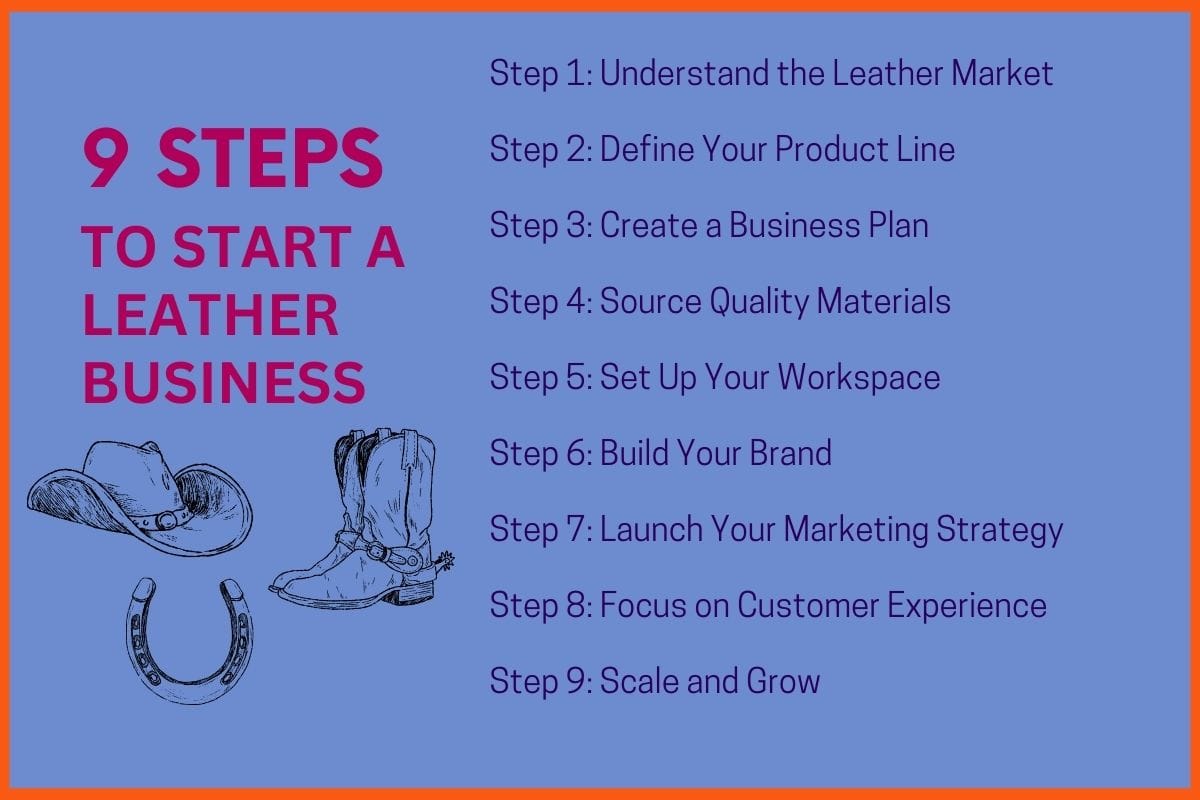How to Start a Leather Business?
📖 Learning
There’s something timeless about leather. It’s a statement of craftsmanship, durability, and luxury. From sleek handbags to rugged boots, leather goods have a universal appeal that transcends trends. If you’ve ever dreamed of turning your passion for leather into a thriving business, you’re in the right place. Starting a leather business is an exciting journey, but like any entrepreneurial venture, it requires careful planning, creativity, and a dash of courage. In this guide, we’ll walk you through the essential steps to launch your leather business, from understanding the market to building a brand that stands out. No matter who you’re: a seasoned crafter or a leather enthusiast looking to dive into the industry, this article will equip you with the tools to turn your vision into reality.
Step 1: Understand the Leather Market
Step 2: Define Your Product Line
Step 3: Create a Business Plan
Step 4: Source Quality Materials
Step 5: Set Up Your Workspace
Step 6: Build Your Brand
Step 7: Launch Your Marketing Strategy
Step 8: Focus on Customer Experience
Step 9: Scale and Grow

Step 1: Understand the Leather Market
Before you dive into the leather business, it’s crucial to understand the market arena. The leather industry is vast, encompassing everything from high-end fashion to automotive upholstery. You should start by researching the different segments — luxury accessories, footwear, furniture, and even niche markets like leather-bound journals or sports equipment. One should pay attention to trends, too. Sustainability is a big buzzword these days, with more consumers seeking eco-friendly and ethically sourced leather products. Are you drawn to the luxury market, or do you see potential in affordable, everyday leather goods? Understanding where your passion aligns with market demand is the first step to carving out your niche.
Step 2: Define Your Product Line
Once you’ve got a handle on the market, it’s time to decide what you’ll actually sell. Will you focus on handcrafted leather bags, bespoke shoes, or perhaps leather furniture? Your product line should reflect your skills, resources, and target audience. For instance, if you’re a skilled artisan, you might start with custom-made leather wallets or belts. If you’re more business-minded, you could explore wholesale leather goods or collaborate with designers to create unique collections. Remember, it’s better to start small and perfect a few products than to spread yourself too thin.

Step 3: Create a Business Plan
Every successful business starts with a solid plan. Your business plan is your roadmap — it outlines your goals, target market, pricing strategy, and financial projections. Start by defining your mission and vision. What makes your leather business unique? Is it your commitment to sustainability, your innovative designs, or your focus on luxury craftsmanship? Next, dive into the numbers. Calculate your startup costs, including materials, equipment, and marketing expenses. Don’t forget to factor in ongoing costs like rent, utilities, and salaries if you plan to hire help. A well-thought-out business plan not only keeps you on track but also helps you secure funding if needed.
Step 4: Source Quality Materials
The heart of any leather business is, of course, the leather itself. Sourcing high-quality materials is non-negotiable if you want to create products that stand out. Research reputable tanneries and suppliers, and don’t be afraid to ask for samples. Look for leather that matches your brand’s ethos—whether it’s full-grain leather for luxury items or eco-friendly options like vegetable-tanned leather. Building strong relationships with suppliers is key. Not only will this ensure consistent quality, but it can also lead to better pricing and exclusive materials down the line.
Step 5: Set Up Your Workspace
No matter if you’re working from a small studio or a larger workshop, your workspace is where the magic happens. Invest in the right tools and equipment, from cutting mats and stitching machines to leather dyes and finishes. If you’re starting small, you don’t need a fancy setup—just a clean, organized space where you can work efficiently.
If you’re planning to sell online, consider setting up a dedicated area for product photography. Good lighting and a neutral background can make all the difference in showcasing your leather goods.
Step 6: Build Your Brand
Your brand is more than just a logo—it’s the story you tell and the emotions you evoke. Start by defining your brand identity. What values do you want to communicate? Is your brand about timeless elegance, rugged durability, or modern minimalism?
Once you’ve nailed down your brand identity, create a visual identity that reflects it. This includes your logo, color palette, and packaging design. Don’t underestimate the power of packaging—unboxing a beautifully wrapped leather product can turn a customer into a lifelong fan.

Step 7: Launch Your Marketing Strategy
Now that you’ve got your products and brand ready, it’s time to spread the word. Start by building an online presence. A professional website is a must, especially if you plan to sell directly to consumers. Use high-quality photos and detailed product descriptions to showcase your leather goods.
Social media is another powerful tool. Platforms like Instagram and Pinterest are perfect for visually-driven industries like leather crafting. Share behind-the-scenes content, customer testimonials, and styling tips to engage your audience.
Don’t forget about traditional marketing tactics, either. Pop-up shops, trade shows, and collaborations with local businesses can help you reach a wider audience.

Step 8: Focus on Customer Experience
In the leather business, customer satisfaction is everything. From the moment someone discovers your brand to the day they receive their order, every interaction should be seamless and enjoyable. Offer excellent customer service, whether it’s through prompt email responses or personalized thank-you notes.
Consider offering customization options, too. Many customers are willing to pay a premium for bespoke leather goods that feel one-of-a-kind.
Step 9: Scale and Grow
As your business gains traction, you’ll start thinking about growth. Maybe you’ll expand your product line, open a retail store, or explore international markets. Whatever your goals, remember to stay true to your brand and values.
Scaling a business comes with its own set of challenges, from managing inventory to hiring the right team. Take it one step at a time, and don’t be afraid to seek advice from mentors or industry experts.

Final Thoughts: Your Leather Journey Begins Now
Starting a leather business is no small feat, but with passion, persistence, and a solid plan, you can turn your dream into a thriving reality. Remember, the leather industry is as much about artistry as it is about business. Stay true to your craft, listen to your customers, and never stop innovating.
And if you’re hungry for more entrepreneurial insights, head over to StartupTalky for more tips, tricks, and inspiration. Follow us on Instagram for daily doses of business wisdom and a behind-the-scenes look at the world of startups. Because at StartupTalky, we believe every great business starts with a great idea—and a little bit of hustle.
Now, go forth and create something extraordinary. The world of leather is waiting for you! 👜✨

FAQs
Do I need a lot of capital to start a leather business?
The capital required varies depending on the scale of your business. Starting small with handcrafted items might need less capital than setting up a manufacturing unit.
Do I need specialized skills to work with leather?
Yes, working with leather requires specific skills like cutting, stitching, tooling, and finishing. You can learn these skills through workshops, online tutorials, or apprenticeships. Alternatively, you can hire skilled artisans.
Must have tools for startups - Recommended by StartupTalky
- Convert Visitors into Leads- SeizeLead
- Website Builder SquareSpace
- Manage your business Smoothly Google Business Suite






